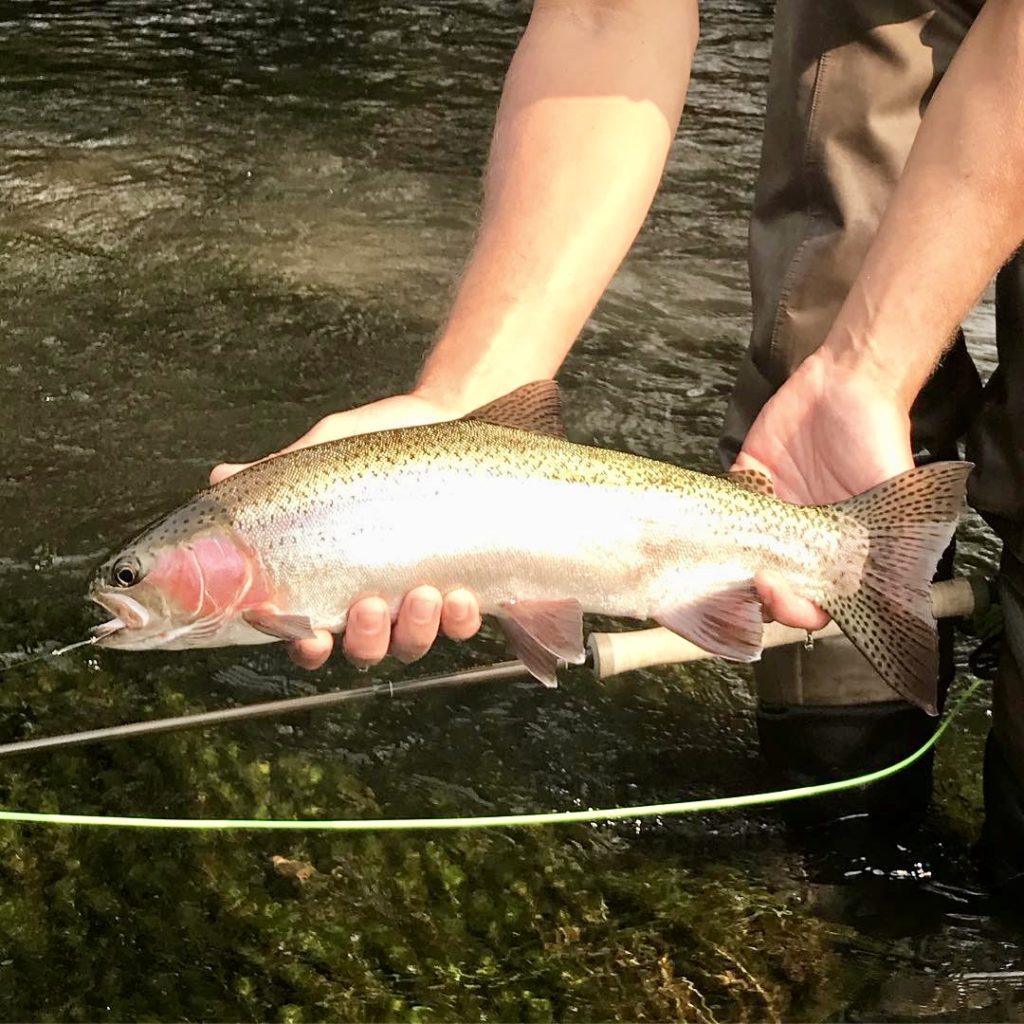
Who, what, where, when, why…and how?
The Who. Anglers who like to swing flies and get lot’s of grabs that’s who. Traditionally, on other rivers where you can fish from a boat you’d have a streamer rod. Deschutes anglers do not have this luxury but with 1500 adult rainbow trout per river mile you know the biggest ones are meat eaters and a long way off the bank. Deschutes anglers, other than eating straight up river or down river don’t have a lot of options to cast single handers at distance. So trout speys…heck ya!
The What. What’s a Trout Spey? Trout Spey’s or Micro Spey are just that rods with spey tapers built for trout instead of they’re larger relatives, Salmon and Steelhead. Typical trout speys are 3 and 4 weight, 5 weights are light steelhead rods. Think of these rods as plus three sizes when comparing to single hand rods. We generally fish heavier than we want to because trout like big flies.
The Where? Believe it or not, many large trout live out in the middle of the steelhead runs. Makes sense right? We’ve been hooking trout incidentally while swinging steelhead flies for years. I like to swing flies for trout when there are no steelhead around.
The When. Whenever you want…but winter and early spring are best. Early in the morning, late in the evening, or on a cloudy calm day. Up your game to swingings of hackles and caddis pupa you can fish most of the summer and early fall.
The Why. As fly-fisherman we use the term “match the hatch”, plain meaning, tie on what you think they are eating or might eat. Primarily considered insect eaters, rainbow trout also eat sculpins and crayfish. So the why is to feed them what they eat.
Sculpin are a giant part of the Deschutes Redside’s diet. In fact at times sculpin, or cotus, make up most of what trout eat! Deschutes Redsides are definitely bug eaters, and they eat sculpin and crayfish for sustainable growth and survival. Trout eat sculpin more than mayflies or caddis, it’s a fact. Trout like sculpin so much that at times they are eaten more than stoneflies (which we know make up the bulk of what they eat).
As a spey freak and trout spey enthusiast I have long noticed that on some days trout kill anything on the swing, sometimes. Even during steelhead season anglers have their steelhead flies intercepted by trout. I have long contended that when trout are not on bugs they will eat a sculpin pattern. This is anecdotal evidence of course but I can’t think of a single time trout fishing when they are off the bug bite that they won’t grab a sculpin pattern.
The How. Swinging streamers on the Deschutes with a trout spey is a lot like steelhead fishing with a spey rod with sink tips. Short Skagit heads, heavy sink tips and sculpin patterns swung down and across, broadside, or straight down river. You can strip them, let them swing or dead drift them.
Trout Speys. Trout Speys come in many configurations, usually 10.5 to 12′ rods 3/4/5 weight designations. For the Deschutes I like 3 and 4 weights, specifically a Gloomis IMX Pro 11’11”, that’s my preference. I like to cat a four weight but prefer to fight fish on the three weight…I fish a four weight 90% of the time. Skagit lines have come a long way allowing anglers to manage heavy payloads with light rods. Typically we fish 10′ sink tips with integrated skagit/running line rigs. Integrated Skagit lines like the SA Skagit light are my go to. I prefer the absence of junction knots where qe go loop to loop. True shooting head lines are available as well making line changes convenient. These set ups are exactly like of our steelhead gear, line changes take seconds and only one reel required.
I find myself fishing 300-330 grain skagit heads with 10′ of T10 or T14. The zone the fly is in is much more critical trout fishing than steelhead fishing. Steelhead will move great distances to eat a fly, as a rule trout, not so much.
All traditional trout streamers catch fish, and to be honest we’re all still trying to dial this thing in tighter. Sculpzilla is a great fly, it’s heavy, available in several colors and readily available. My favorite fly could just as easily be a bead head holly bugger. You don’t need a whole box of flies (but it’s nice). Do not leave home with out a white streamer! Anglers should have four colors; black, brown, olive, white. Half and half flies work well too.
Fish heavy tippet, Deschutes fish are not line shy. Just because you are trout fishing doesn’t mean you have to fish 3x,4x,6x. Think 1x or 8lb maxima, tie your flies on with a loop and they’ll move plenty.
Location. If you’re in a good spot, I mean a spot you know is trout heavy try a number of flies and tips. Place with swing speed and angle. Throw a strip or a twitch into your swing. Try and upstream cast with a downstream retrieve. Mix it up! Have fun! Catch fish!
Call me with questions or to book a trip! Sam Sickles (541) 400-0855 [email protected]





